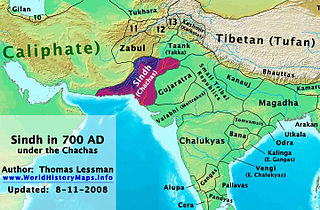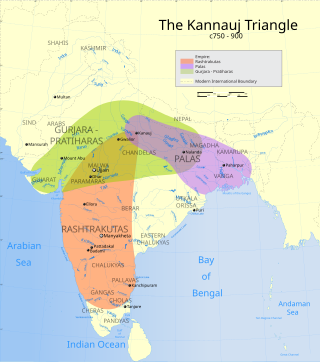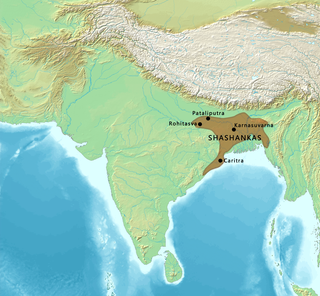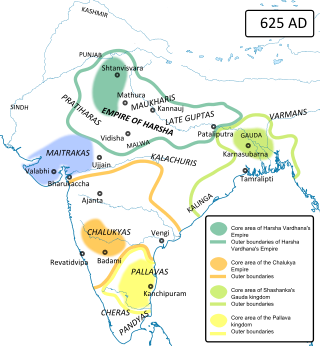
The middle kingdoms of India were the political entities in the Indian subcontinent from 230 BCE to 1206 CE. The period begins after the decline of the Maurya Empire and the corresponding rise of the Satavahana dynasty, starting with Simuka, from 230 BCE. The "middle" period lasted for almost 1436 years and ended in 1206 CE, with the rise of the Delhi Sultanate, founded in 1206, and the end of the Later Cholas.

Kannauj is a city, administrative headquarters and a municipal board or Nagar Palika Parishad in Kannauj district in the Indian state of Uttar Pradesh. The city's name is an evolved form of the classical name Kanyakubja. It was also known as Mahodaya during the time of Mihira Bhoja. It is situated 104 kilometres west of the state capital, Lucknow.

The Gurjara-Pratihara was a dynasty that ruled much of Northern India from the mid-8th to the 11th century. They ruled first at Ujjain and later at Kannauj.

Lalitaditya alias Muktapida was a monarch belonging to the Karkota dynasty of Kashmir region in the Indian subcontinent.

Shashanka was the first independent king of a unified polity in the Bengal region, called the Gauda Kingdom and is a major figure in Bengali history. He reigned in the 7th century, some historians place his rule between circa 600 CE and 636/7 CE, whereas other sources place his reign between 590 and 625 CE.
Nagabhata II was an Indian Emperor from Gurjara-Pratihara dynasty. He ascended the throne of Gurjara-Pratihara dynasty after his father Vatsraja. His mother was queen Sundari-Devi. He was designated with imperial titles - Paramabhattaraka, Maharajadhiraja, and Paramesvara after conquest of Kannauj.

In the first half of the 8th century CE, a series of battles took place in the Indian subcontinent between armies of the Umayyad Caliphate and Indian kingdoms situated to the east of the Indus river, as subsequent to the Arab conquest of Sindh in present-day Pakistan in 711 CE, Arab armies engaged kingdoms further east of the Indus. Between 724 and 810 CE, a series of battles took place between the Arabs and Nagabhata I of the Gurjara-Pratihara dynasty, Vikramaditya II of the Chalukya dynasty, and other small Indian kingdoms. In the north, Nagabhata of the Pratihara Dynasty defeated a major Arab expedition in Malwa. From the South, Vikramaditya II sent his general Avanijanashraya Pulakeshin, who defeated the Arabs in Gujarat. Later in 776 CE, a naval expedition by the Arabs was defeated by the Saindhava naval fleet under Agguka I.

The Paramara Dynasty was an Indian dynasty that ruled Malwa and surrounding areas in west-central India between 9th and 14th centuries. They belonged to the Parmara clan of the Rajputs.

The Tripartite Struggle, also known as The Kannauj Triangle Wars, for control of northern India took place in the ninth century, among the Gurjara-Pratihara Empire, the Pala Empire and the Rashtrakuta Empire.

The Gauḍa Kingdom or Shashankas, was a classic kingdom during the Classical period on the Indian subcontinent, which originated in the Gauda region of Bengal in 4th century CE or possibly earlier.

Yashovarman was a medieval Indian ruler of Kannauj who founded the Varman dynasty of Kannauj. There are few sources that provide information of his life, although he was indubitably a powerful man.

The Chaulukya dynasty, also Solanki dynasty, was a dynasty that ruled parts of what are now Gujarat and Rajasthan in north-western India, between c. 940 CE and c. 1244 CE. Their capital was located at Anahilavada. At times, their rule extended to the Malwa region in present-day Madhya Pradesh. The family is also known as the "Solanki dynasty" in the vernacular literature. They belonged to the Solanki clan of Rajputs.
The origin of the Gurjara-Pratihara dynasty of India is a topic of debate among historians. The rulers of this dynasty used the self-designation "Pratihara" for their clan, but have been described as "Gurjara" by their neighbouring kingdoms. Only one particular inscription of a feudatory ruler named Mathanadeva mentions him as a "Gurjara-Pratihara".
The Pratiharas of Mandavyapura, also known as the Pratiharas of Mandore, were an Indian dynasty. They ruled parts of the present-day Rajasthan between 6th and 9th centuries CE. They first established their capital at Mandavyapura, and later ruled from Medantaka.

The Pushyabhuti dynasty, also known as the Vardhana dynasty, was ruling dynasty in northern India during the 6th and 7th centuries. The dynasty reached its zenith under its last ruler Harsha Vardhana, and the Empire of Harsha covered much of north and north-western India, extending till Kamarupa in the east and Narmada River in the south. The dynasty initially ruled from Sthanveshvara, but Harsha eventually made Kanyakubja his capital, from where he ruled until 647 CE.

The Later Gupta dynasty ruled Magadha in eastern India between the 6th and 8th centuries CE. The Later Guptas succeeded the Imperial Guptas as the rulers of eastern Malwa or Magadha, but there is no evidence connecting the two dynasties; these appear to be two distinct families. The "Later Guptas" are so-called because the names of their rulers ended with the suffix "-gupta", which they might have adopted to portray themselves as the successors of the Imperial Guptas.
Āma was a medieval Indian king who ruled Kannauj and surrounding areas during the 8th and the 9th centuries. According to the Jain chronicles, he was the son and successor of Yashovarman.
Dunduka was a king of the state of Kannauj in North India during the early 8th century CE.
Bhoja was a medieval Indian king who ruled Kannauj in the late 8th century CE.
The Ayudha dynasty was the short-lived, second dynasty of the Kannauj State from the late 8th to the early 9th century CE.















